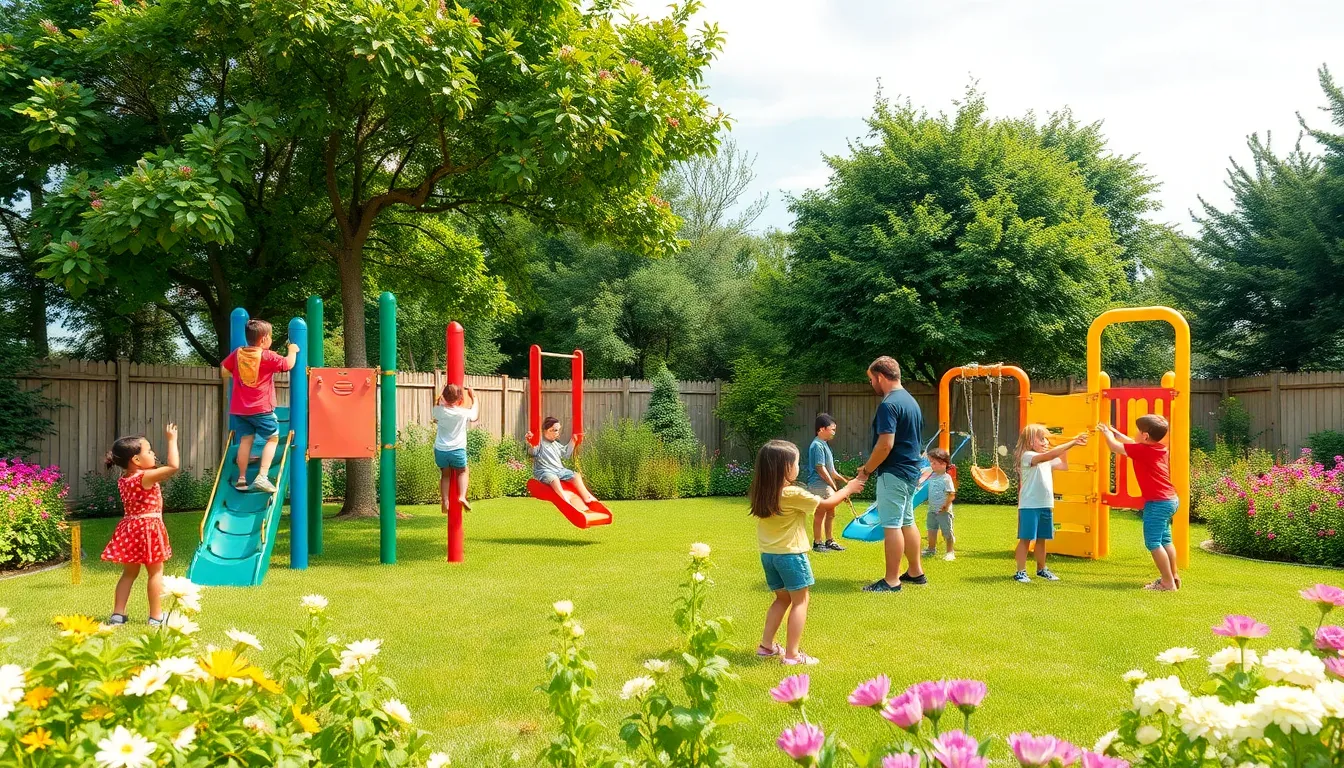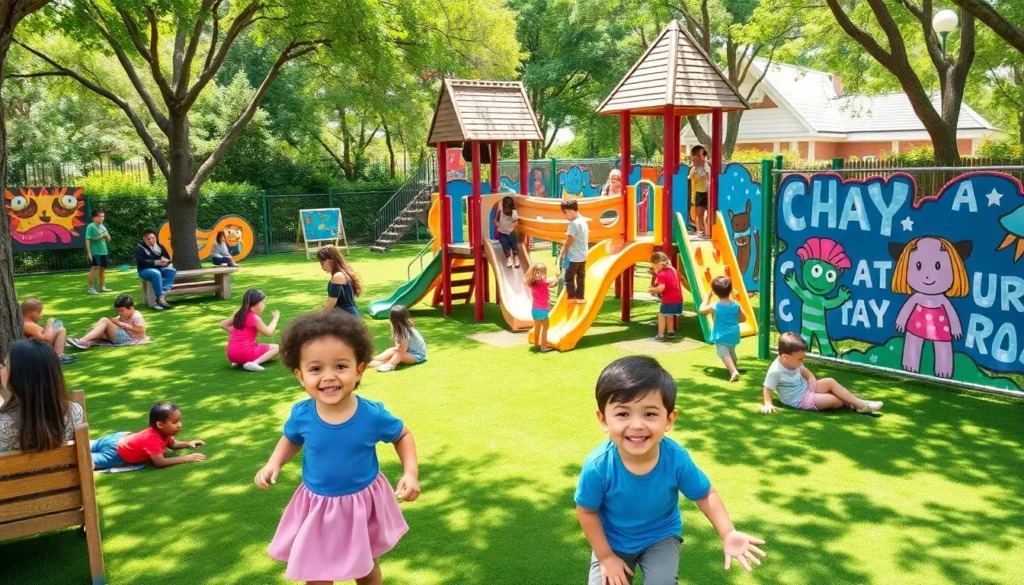Table of Contents
ToggleImagine a place where laughter echoes, imagination runs wild, and dirt is just a badge of honor. Welcome to the Play Garden, a magical realm where kids can unleash their inner adventurers while parents sip coffee and pretend to be on top of things. This isn’t just any ordinary playground; it’s a vibrant wonderland designed to inspire creativity and promote healthy play.
Overview of Play Garden
Play Garden serves as an innovative space designed for children’s active engagement. This playground features a variety of interactive elements that spark creativity. Statistically, play areas like this enhance physical activity levels by over 30%, promoting health and well-being.
Structured zones within Play Garden encourage imaginative role play. Climbing structures, swings, and slides cater to diverse interests and developmental stages. Natural landscaping incorporates elements like trees and gardens, providing a serene backdrop for play.
Families can relax in comfortable seating areas while observing their children’s joyous exploration. Accessible designs ensure everyone can enjoy the space, including children with disabilities. Additionally, safety features like soft ground surfaces minimize the risk of injury, creating a worry-free environment.
Community involvement enhances the impact of the Play Garden. Local artists contribute colorful murals, creating a vibrant atmosphere. Educational programs offer workshops focused on environmental awareness and creativity.
Feedback from parents indicates satisfaction with the space’s design and concept. Cleanliness and maintenance are priorities, ensuring a pleasant experience for all visitors. Popularity continues to grow, making it a central hub for families seeking engaging outdoor activities.
Each aspect of Play Garden promotes healthy social interactions. Collaborating with peers fosters communication skills and teamwork. As a result, children develop friendships and learn vital life skills through play.
Benefits of a Play Garden

The Play Garden offers numerous benefits that enhance children’s overall development, fueling their growth and joy.
Cognitive Development
Cognitive development flourishes in the Play Garden. Engaging with interactive elements stimulates children’s imagination and critical thinking skills. Playtime experiences encourage problem-solving, as they navigate climbing structures and figure out how to conquer slides. Natural landscaping features, like trees and gardens, inspire curiosity about the environment. Unique play zones promote role-play scenarios, allowing children to explore various perspectives and enrich their understanding of the world around them.
Physical Health
Physical health improves significantly through activities offered at the Play Garden. Children increase their physical activity levels by over 30% while climbing, swinging, and running. The soft ground surfaces reduce injury risks, making outdoor play safer. Regular engagement in such activities helps build strength, coordination, and flexibility. Active play leads to healthier lifestyles, preventing obesity and promoting cardiovascular health. Outdoor environments encourage fresh air and sunlight exposure, contributing to overall well-being.
Social Skills
Social skills develop through play in a communal space like the Play Garden. Collaborative play encourages teamwork as children share equipment and engage in group activities. Friendships form quickly when children interact in relaxed environments, helping them build communication skills. Participating in role-playing games enhances empathy, as children learn to understand others’ emotions and perspectives. Each interaction strengthens their ability to resolve conflicts and establish meaningful connections, fostering a sense of community.
Designing a Play Garden
Designing a Play Garden involves thoughtful selection of plant varieties and intentional creation of play zones to enhance children’s experiences.
Choosing Plant Varieties
Selecting appropriate plant varieties matters for creating a vibrant environment. Focus on native plants that require less maintenance and provide natural habitats for local wildlife. Incorporating diverse species encourages discovery as children explore various textures and colors. Opt for non-toxic plants to ensure safety during play. Adding sensory plants like lavender or mint can stimulate children’s senses. These plants not only beautify the garden but also foster connection with nature, enriching their play experience.
Creating Play Zones
Creating distinct play zones allows for varied activities that cater to different interests. Design spaces for physical challenges, such as climbing structures and balance beams, to promote active play. Arrange areas for imaginative role play, incorporating themed elements like a pirate ship or fairy castle. Incorporate shaded spots with seating for relaxation and social interaction, enhancing community connections. Allocate sensory zones featuring sound and tactile elements, ensuring all children can engage fully. Each zone should connect seamlessly, creating a cohesive play experience that encourages exploration and creativity.
Maintenance Tips for Play Gardens
Play Gardens require regular maintenance to ensure a safe and enjoyable environment for children. Following specific care routines helps maintain their vibrant features and fosters healthy play.
Seasonal Care
Seasonal care involves adjusting maintenance tasks to accommodate changing weather conditions. In spring, parents should inspect play equipment for damage caused by winter. Cleaning debris from play surfaces boosts overall safety. Summer calls for regular checks on shade structures and water features to ensure functionality and hygiene. During autumn, leaves must be cleared to prevent slippery surfaces. Winter weather demands close monitoring of equipment for freezing conditions. Providing proper maintenance throughout the seasons enhances longevity and playability.
Safety Considerations
Safety considerations are crucial for maintaining a secure Play Garden. Regular inspections of play structures for wear or damage keep children safe during play. Soft ground surfaces should be checked for erosion or displacement. Designated pathways must remain clear and free of obstacles to minimize tripping hazards. Having appropriate safety signage promotes awareness of rules and guidelines for all users. Engaging the community in safety patrols creates a culture of collective responsibility and care for the space. Implementing these measures ensures a worry-free environment for both children and their families.
The Play Garden stands as a vibrant testament to the importance of imaginative play and community engagement. Its thoughtfully designed spaces not only enhance children’s physical and cognitive development but also foster social connections among families. By prioritizing safety and accessibility, it ensures that every child can enjoy the magic of play without worry.
As families gather in this enchanting environment, they cultivate memories and friendships that will last a lifetime. The Play Garden is more than just a playground; it’s a nurturing haven where creativity thrives and children can truly be themselves. With ongoing community support and maintenance, this unique space will continue to inspire joy and exploration for generations to come.




